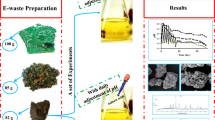Abstract
The bacterial leaching of zinc and iron from solid wastes at the Isdemir iron and steel plant has been investigated using Acidithiobacillus ferrooxidans as the bacterial agent. The effects of a range of operational parameters, including particle size, solids concentration and pH, on the efficiency of the bioleaching process were investigated. In each test, several variables were determined to assess the efficiency of leaching, including slurry pH and redox potential, temperature, bacteria population and concentrations of zinc and iron in solution. Experimental results demonstrated that pulp solids concentration, slurry pH and solids particle size were all important parameters in the bacterial leaching process. Maximum extraction was achieved at pH values around 1.3 and a solids concentration of 1% w/v, with 35% of the Zn content and 37% of the Fe being dissolved.








Similar content being viewed by others
References
Szekely, J. (1996). Steelmaking and industrial ecology is steel a green material? ISIJ International, 36, 121–135.
Leclerc, N., Meux, E., & Lecuire, J. M. (2003). Hydrometallurgical extraction of zinc from zinc ferrites. Hydrometallurgy, 70, 175–183.
Thakur, P. K. (2000). Utilization of steel melting slag to generate wealth from waste. Proceedings of conference on environmental management in metallurgical industries, BHU, Varanasi, India (pp. 187–193).
Yadav, U. S., Das, B. K., & Kumar, A. (2001). Recovery of mineral values from integrated steel plant waste. Proceedings of 6th southern hemisphere meeting on mineral technology, Brazil (pp. 719–725).
Zhao, Y., & Stanforth, R. (2000). Extraction of zinc from zinc ferrites by fusion with caustic soda. Minerals Engineering, 13, 1417–1421.
Olper, M. (1985). Recycling of metals and engineered materials. Minerals Metals and Materials Society, (pp. 563–578).
Lundgren, D. G., Vakova-Valchanova, M., & Reed, R. (1986). Chemical reactions important in bioleaching and bioaccumulation. Biotechnology and Bioengineering Symposium, 16, 7–21.
Zunkel, A. D. (1997). Electric arc furnace dust management: A review of technologies. Iron and Steel Engineer, 74(3), 33–38.
Haddadin, J., Dagot, C., & Fick, M. (1995). Models of bacterial leaching. Enzyme and Microbial Technology, 17, 290–305.
Sampson, M. I., Phillips, C. V., & Blake, R. C. (2000). Influence of the attachment of acidophilic bacteria during the oxidation of mineral sulphides. Minerals Engineering, 13, 373–389.
Sand, W., Gehrke, T., Jozsa, D. G., & Schippers, A. (2001). Biochemistry of bacterial leaching direct versus indirect bioleaching. Hydrometallurgy, 59, 159–175.
Olson, G. J., Brierley, J. A., & Brierley, C. L. (2003). Bioleaching review part B. Progress in bioleaching applications of microbial processes by the minerals industries. Applied Microbiology and Biotechnology, 63, 249–257.
Rodriguez, Y., Ballester, A., Blazquez, M. L., Gonzalez, F., & Munoz, J. A. (2003). New information on the sphalerite bioleaching mechanism at low and high temperature. Hydrometallurgy, 71, 57–66.
Gupta, A., Birendra, K., & Mishra, R. (2003). Study on the recovery of zinc from Moore cake: A biotechnological approach. Minerals Engineering, 16, 41–43.
Mulligan, C. N., Kamali, M., & Gibbs, B. F. (2004). Bioleaching of heavy metals from a low grade ore using Aspergillus niger. Journal of Hazardous Materials, 110, 77–84.
Liao, M. X., & Deng, T. L. (2004). Zinc and lead extraction from complex raw sulphides by sequential bioleaching and acidic brine leach. Minerals Engineering, 17, 17–22.
Pina, P. S., Leao, V. A., Silva, C. A., Daman, D., & Frenay, Y. J. (2005). The effect of ferrous and ferric iron and sphalerite bioleaching with Acidithiobacillus sp. Minerals Engineering, 18, 549–551.
Keeling, S. E., Palmer, M. L., Caracatsanis, F. C., Johnson, J. A., & Watling, H. R. (2005). Leaching of chalcopyrite and sphalerite using bacteria enriched from a spent chalcocite heap. Minerals Engineering, 18, 1289–1296.
Shi, S., Fang, Z., & Ni, J. (2006). Comparative study on the bioleaching of zinc sulphides. Process Biochemistry, 41, 438–446.
Mack, C., Wilhelmi, B., Duncan, J. R., & Burgess, J. E. (2007). Biosorption of precious metals. Biotechnology Advances, 25, 264–271.
de Souza, A. D., Pina, P. S., & Leão, V. A. (2007). Bioleaching and chemical leaching as an integrated process in the zinc industry. Minerals Engineering, 20, 591–599.
Veglio, F., Beolchini, F., Nardini, A., & Toro, L. (2000). Bioleaching of a pyrrhotite ore by sulfo-oxidans strain. Chemical Engineering Science, 55, 783–795.
Wong, J. K., & Henry, J. G. (1988). Bacterial leaching of heavy metals from anaerobically digested sludge. In D. L. Wise (Ed.), Biotreatment systems (pp. 125–169). Boca Raton, FL: CRC.
Jensen, A. B., & Webb, C. (1995). Ferrous sulphate oxidation using Thiobacillus ferrooxidans: A review. Process Biochemistry, 30, 225–236.
Silverman, P., & Lundgren, D. G. (1969). Studies on chemoautotrophic bacterium ferrobacillus ferroxidans. Journal of Bacteria, 77, 642–647.
Ronald, M. A. (1997). Handbook of microbiological media, (2nd ed.). New York: CPC Press Co.
Blancarte-Zurita, M. A., Branion, R. M. R., & Lawrence, R. W. (1987). Application of a shrinking particle model to the kinetics of microbiological leaching. In R. W. Lawrence, R. M. R. Branion, & H. G. Ebner (Eds.), Fundamental and applied biohydrometallurgy (pp. 243–253). Amsterdam: Elsevier.
Froment, G. F., & Bischoff, K. B. (1979). Chemical reactor analysis and design. New York: Wiley.
Woznick, D. J., & Huang, J. Y. C. (1991). Variables affecting metal removal from sludge. Journal of Water Pollution Control, 54, 1574–1580.
Acknowledgements
Financial support for this work was provided under project MMF2004-BAP7. The authors also wish to thank Isdemir AS for providing test samples and laboratory facilities.
Author information
Authors and Affiliations
Corresponding author
Rights and permissions
About this article
Cite this article
Bayat, O., Sever, E., Bayat, B. et al. Bioleaching of Zinc and Iron from Steel Plant Waste using Acidithiobacillus Ferrooxidans . Appl Biochem Biotechnol 152, 117–126 (2009). https://doi.org/10.1007/s12010-008-8257-5
Received:
Accepted:
Published:
Issue Date:
DOI: https://doi.org/10.1007/s12010-008-8257-5




